Determination of Low Concentrations of Mercury Based on the Electrodeposition Time
Abstract
1. Introduction
2. Materials and Methods
2.1. Materials and Instrumentation
2.2. Time Response Electrochemical Detection
2.3. Data Analysis of the Mercury Determination in Solution
2.4. Electrochemical Detection of Mercury in a Soil Eluent
3. Results and Discussion
3.1. Property of a Gold Nanoparticle-Modified Boron-Doped Diamond Electrode
3.2. Optimization of the Measurement Conditions for High-Sensitivity Mercury Detection
3.3. Time Response Detection of Low-Concentration Mercury
3.4. Real Sample Measurement
4. Conclusions
Supplementary Materials
Author Contributions
Funding
Data Availability Statement
Conflicts of Interest
References
- Clarkson, T.W. The toxicology of mercury. Crit Rev. Clin. Lab Sci. 1997, 34, 369–403. [Google Scholar] [CrossRef]
- Rice, K.M.; Walker, E.M., Jr.; Wu, M.; Gillette, C.; Blough, E.R. Environmental mercury and its toxic effects. J. Prev. Med. Public Health 2014, 47, 74–83. [Google Scholar] [CrossRef]
- Driscoll, C.T.; Mason, R.P.; Chan, H.M.; Jacob, D.J.; Pirrone, N. Mercury as a global pollutant: Sources, pathways, and effects. Environ. Sci. Technol. 2013, 47, 4967–4983. [Google Scholar] [CrossRef] [PubMed]
- Boening, D.W. Ecological effects, transport, and fate of mercury: A general review. Chemosphere 2000, 40, 1335–1351. [Google Scholar] [CrossRef]
- Sakata, M.; Marumoto, K. Wet and dry deposition fluxes of mercury in Japan. Atmos. Environ. 2005, 39, 3139–3146. [Google Scholar] [CrossRef]
- Zhang, Y.; Nakai, S.; Masunaga, S. An exposure assessment of methyl mercury via fish consumption for the Japanese population. Risk Anal. 2009, 29, 1281–1291. [Google Scholar] [CrossRef]
- Li, P.; Feng, X.B.; Qiu, G.L.; Shang, L.H.; Li, Z.G. Mercury pollution in Asia: A review of the contaminated sites. J. Hazard. Mater. 2009, 168, 591–601. [Google Scholar] [CrossRef]
- Basu, N.; Horvat, M.; Evers, D.C.; Zastenskaya, I.; Weihe, P.; Tempowski, J. A state-of-the-science review of mercury biomarkers in human populations worldwide between 2000 and 2018. Environ. Health Perspect. 2018, 126, 106001. [Google Scholar] [CrossRef] [PubMed]
- dos Santos, J.S.; de la Guárdia, M.; Pastor, A.; dos Santos, M.L.P. Determination of organic and inorganic mercury species in water and sediment samples by HPLC on-line coupled with ICP-MS. Talanta 2009, 80, 207–211. [Google Scholar] [CrossRef]
- Li, Y.; Chen, C.; Li, B.; Sun, J.; Wang, J.; Gao, Y.; Zhao, Y.; Chai, Z. Elimination efficiency of different reagents for the memory effect of mercury using ICP-MS. J. Anal. At. Spectrom. 2006, 21, 94–96. [Google Scholar] [CrossRef]
- Jagtap, R.; Maher, W. Measurement of mercury species in sediments and soils by HPLC–ICPMS. Microchem. J. 2015, 121, 65–98. [Google Scholar] [CrossRef]
- Hylander, L.D.; Goodsite, M.E. Environmental costs of mercury pollution. Sci. Total. Environ. 2006, 368, 352–370. [Google Scholar] [CrossRef] [PubMed]
- Feng, X.-B.; Chou, A.-L.; Fu, H.-W.; He, T.-R.; Li, B.; Yu, S.-F. Mercury pollution in the environment. Prog. Chem. 2009, 21, 436. [Google Scholar]
- Budnik, L.T.; Casteleyn, L. Mercury pollution in modern times and its socio-medical consequences. Sci. Total. Environ. 2019, 654, 720–734. [Google Scholar] [CrossRef] [PubMed]
- Gustin, M.S.; Evers, D.C.; Bank, M.S.; Hammerschmidt, C.R.; Pierce, A.; Basu, N.; Blum, J.; Bustamante, P.; Chen, C.; Driscoll, C.T.; et al. Importance of Integration and Implementation of Emerging and Future Mercury Research Into the Minamata Convention. Environ. Sci. Technol. 2016, 50, 6, 2767–2770. [Google Scholar] [CrossRef] [PubMed]
- Huang, J.-H.; Shetaya, W.H.; Osterwalder, S. Determination of (Bio)-available mercury in soils: A review. Environ. Pollut. 2020, 263, 114323. [Google Scholar] [CrossRef] [PubMed]
- Kumari, S.; Amit, R.; Jamwal, R.; Mishra, N.; Singh, D.K. Recent developments in environmental mercury bioremediation and its toxicity: A review. Environ. Nanotechnol. Monit. Manag. 2020, 13, 100283. [Google Scholar] [CrossRef]
- Cabañero Ortiz, A.I.; Madrid Albarrán, Y.; Cámara Rica, C. Evaluation of different sample pre-treatment and extraction procedures for mercury speciation in fish samples. J. Anal. At. Spectrom. 2002, 17, 1595–1601. [Google Scholar] [CrossRef]
- Qvarnström, J.; Frech, W. Mercury species transformations during sample pre-treatment of biological tissues studied by HPLC-ICP-MS. J. Anal. At. Spectrom. 2002, 17, 1486–1491. [Google Scholar] [CrossRef]
- Leopold, K.; Foulkes, M.; Worsfold, P. Methods for the determination and speciation of mercury in natural waters—A review. Anal. Chim. Acta. 2010, 663, 127–138. [Google Scholar] [CrossRef]
- Miao, P.; Liu, L.; Li, Y.; Li, G. A novel electrochemical method to detect mercury (II) ions. Electrochem. Commun. 2009, 11, 1904–1907. [Google Scholar] [CrossRef]
- Du, J.; Jiang, L.; Shao, Q.; Liu, X.; Marks, R.S.; Ma, J.; Chen, X. Colorimetric detection of mercury ions based on plasmonic nanoparticles. Small 2013, 9, 1467–1481. [Google Scholar] [CrossRef] [PubMed]
- Ye, B.C.; Yin, B.C. Highly sensitive detection of mercury (II). Angew. Chem. Int. Ed. Engl. 2008, 47, 8386–8389. [Google Scholar] [CrossRef] [PubMed]
- Balasurya, S.; Syed, A.; Thomas, A.M.; Marraiki, N.; Elgorban, A.M.; Raju, L.L.; Das, A.; Khan, S.S. Rapid colorimetric detection of mercury using silver nanoparticles in the presence of methionine. Spectrochim. Acta A Mol. Biomol. Spectrosc. 2020, 228, 117712. [Google Scholar] [CrossRef] [PubMed]
- Horvat, M. Determination of mercury and its compounds in water, sediment, soil and biological samples. In Dynamics of Mercury Pollution on Regional and Global Scales: Atmospheric Processes and Human Exposures Around the World; Springer Naure: Berlin, Germany, 2005; pp. 153–190. [Google Scholar] [CrossRef]
- Ohmagari, S.; Srimongkon, K.; Yamada, H.; Umezawa, H.; Tsubouchi, N.; Chayahara, A.; Shikata, S.; Mokuno, Y. Low resistivity p+ diamond (100) films fabricated by hot-filament chemical vapor deposition. Diam. Relat. Mater. 2015, 58, 110–114. [Google Scholar] [CrossRef]
- Takemura, K.; Iwasaki, W.; Morita, N.; Ohmagari, S. High density and monodisperse electrochemical gold nanoparticle synthesis utilizing the properties of boron-doped diamond electrodes. Nanomaterials 2022, 12, 1741. [Google Scholar] [CrossRef] [PubMed]
- Bottari, F.; De Wael, K. Electrodeposition of gold nanoparticles on boron doped diamond electrodes for the enhanced reduction of small organic molecules. J. Electroanal. Chem. 2017, 15, 521–526. [Google Scholar] [CrossRef]
- Kodamatani, H.; Tomiyasu, T. Selective determination method for measurement of methylmercury and ethylmercury in soil/sediment samples using high-performance liquid chromatography–chemiluminescence detection coupled with simple extraction technique. J. Chromatogr. A 2013, 1288, 155–159. [Google Scholar] [CrossRef]
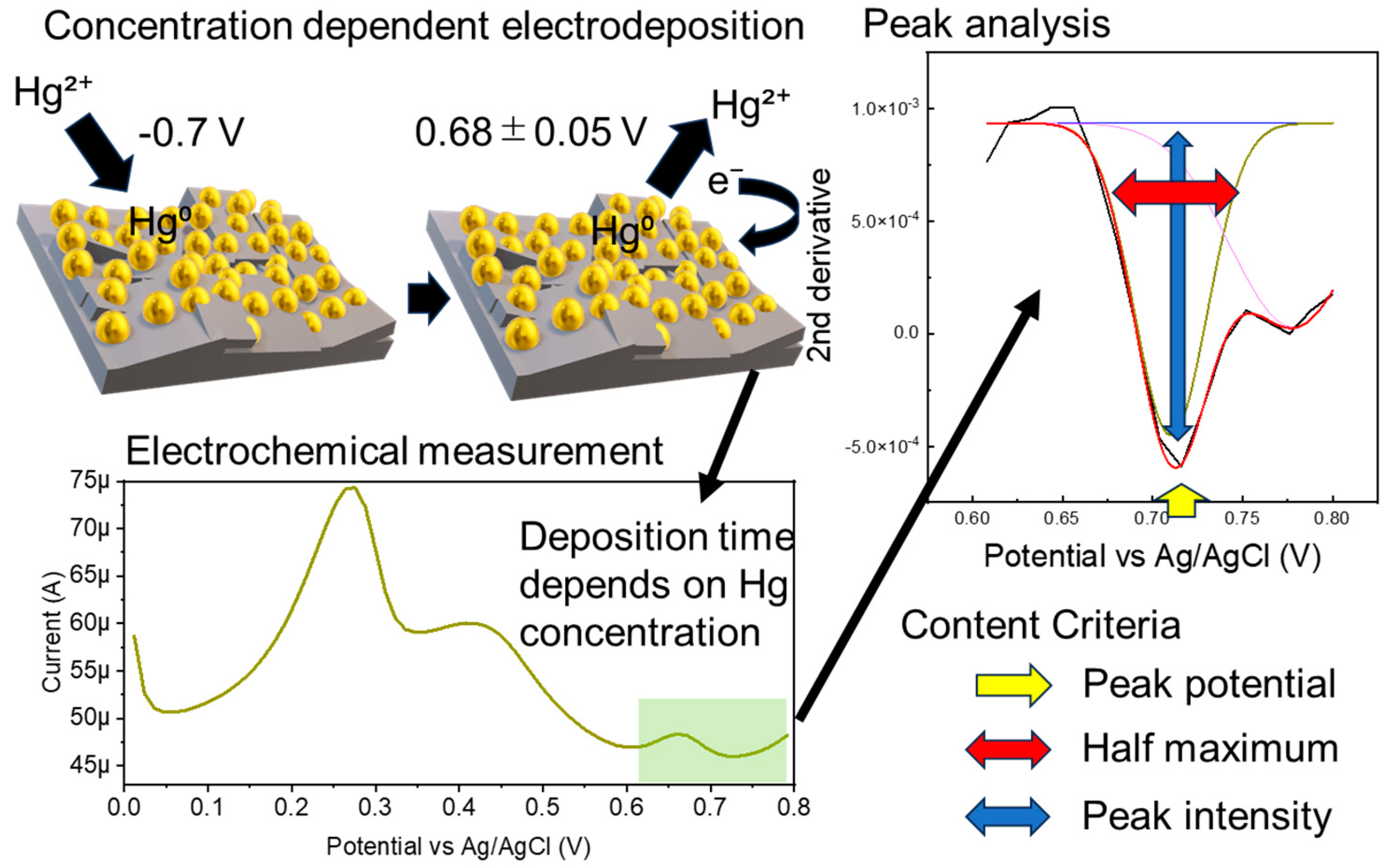
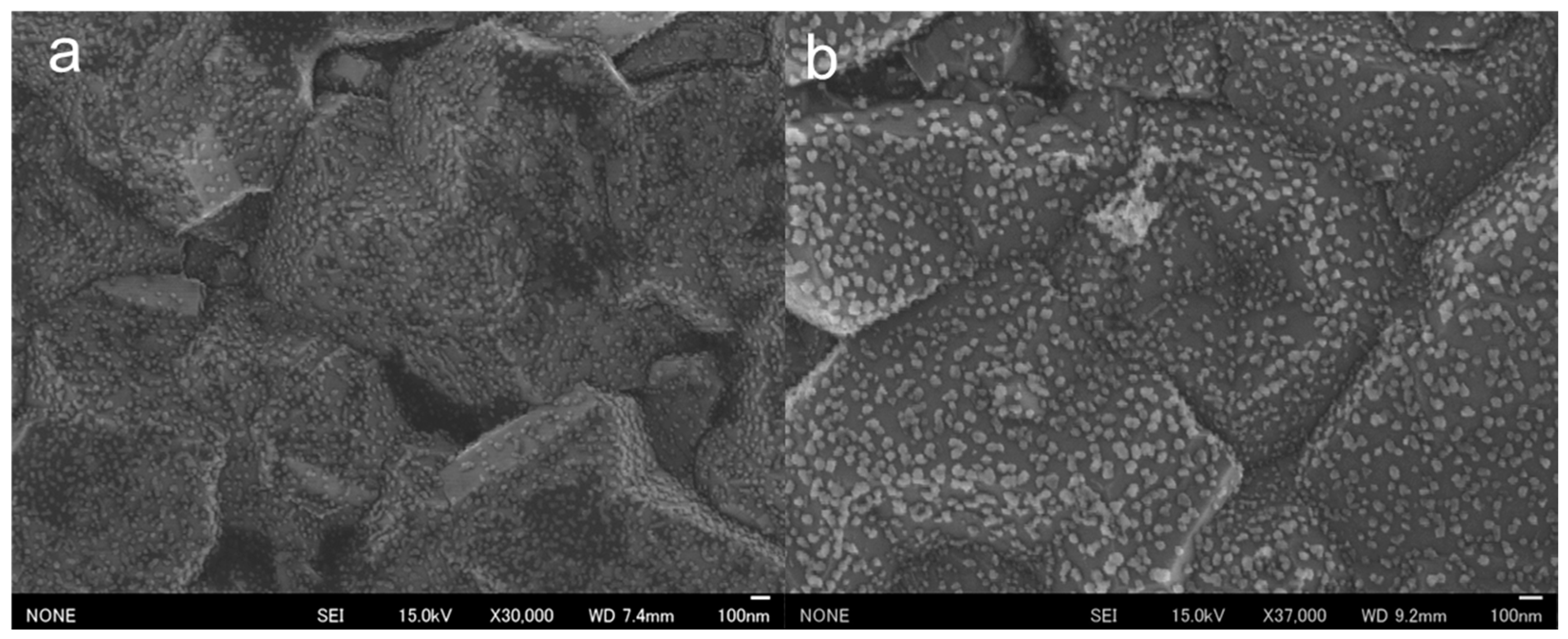
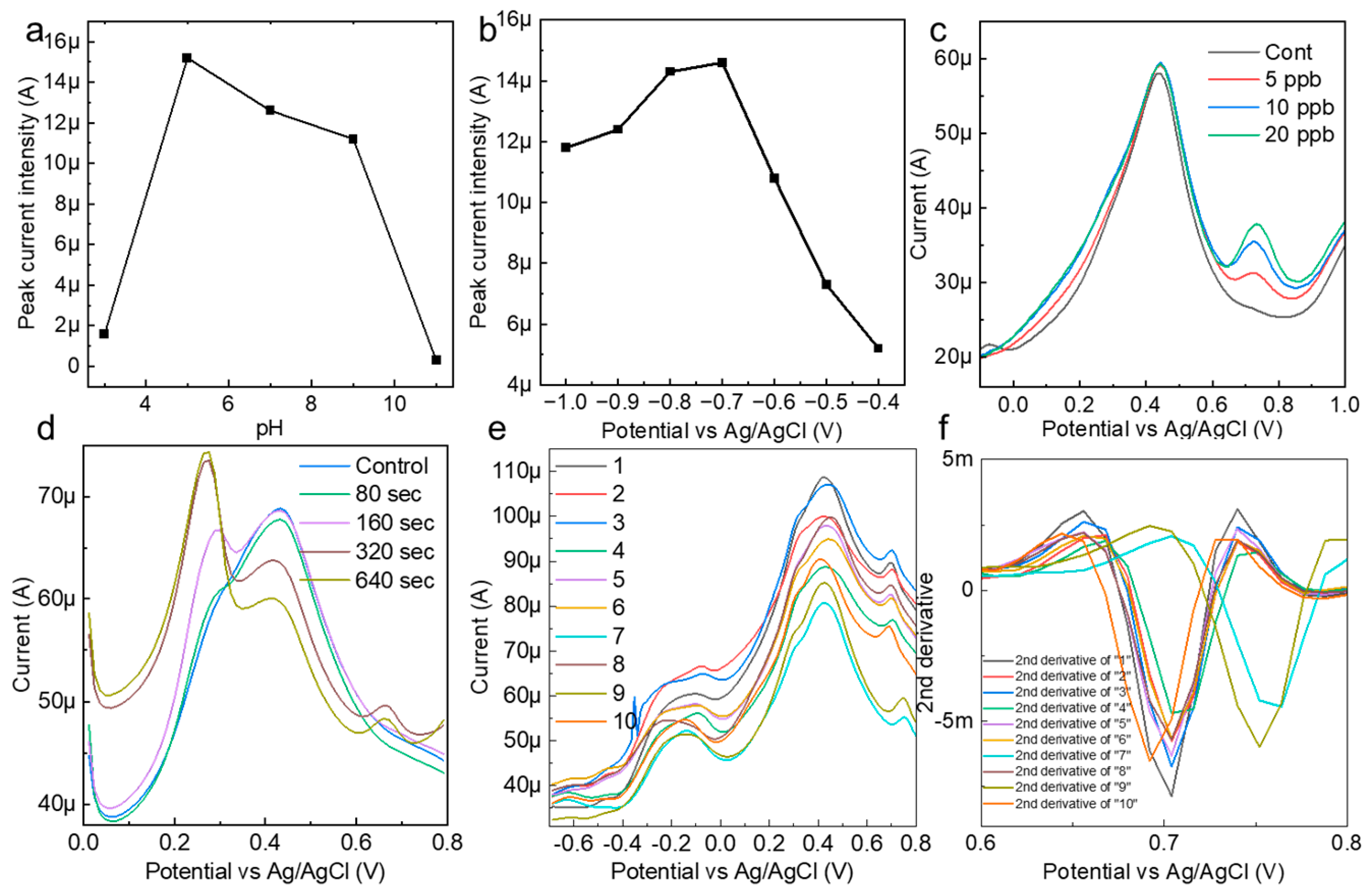
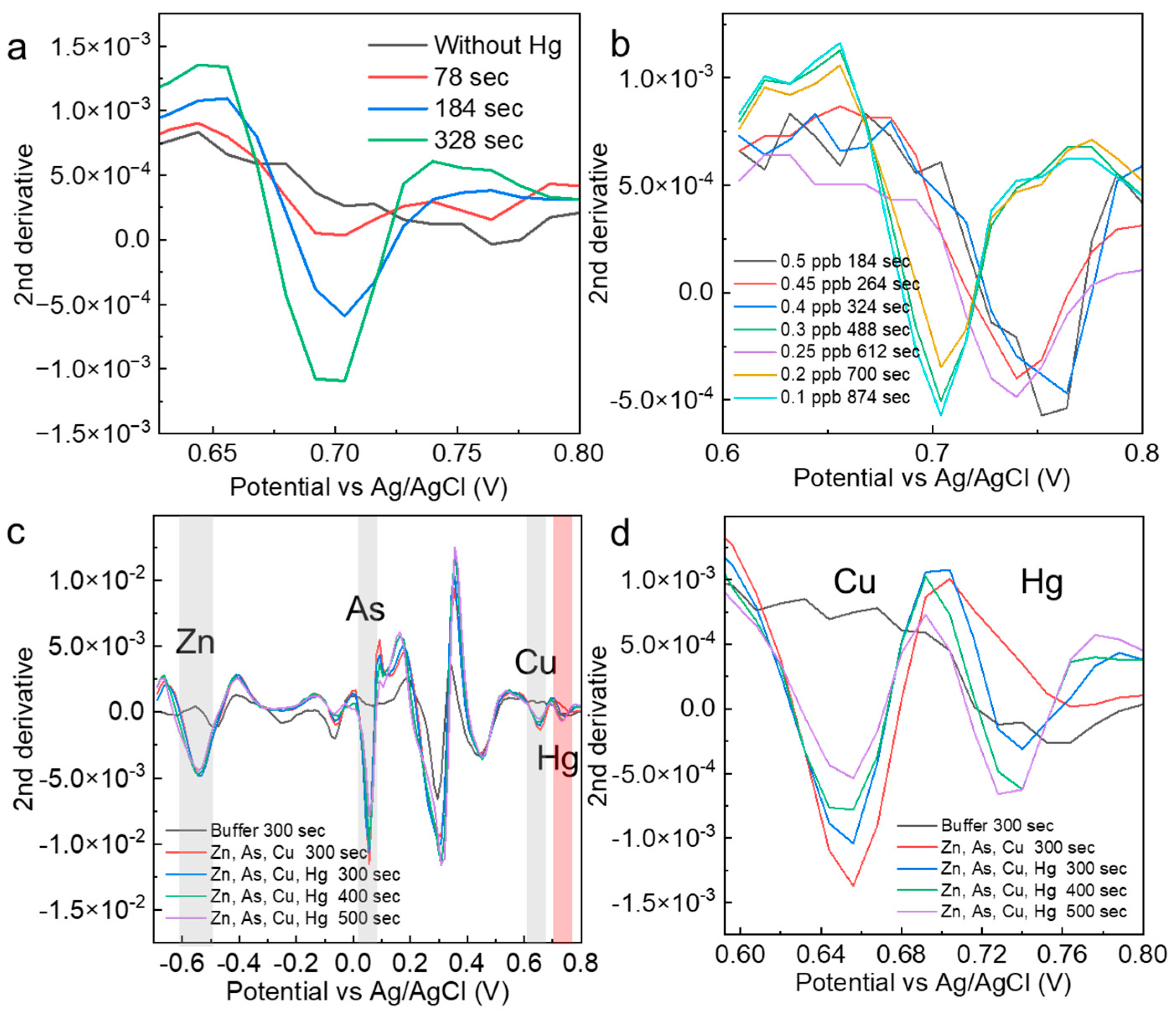
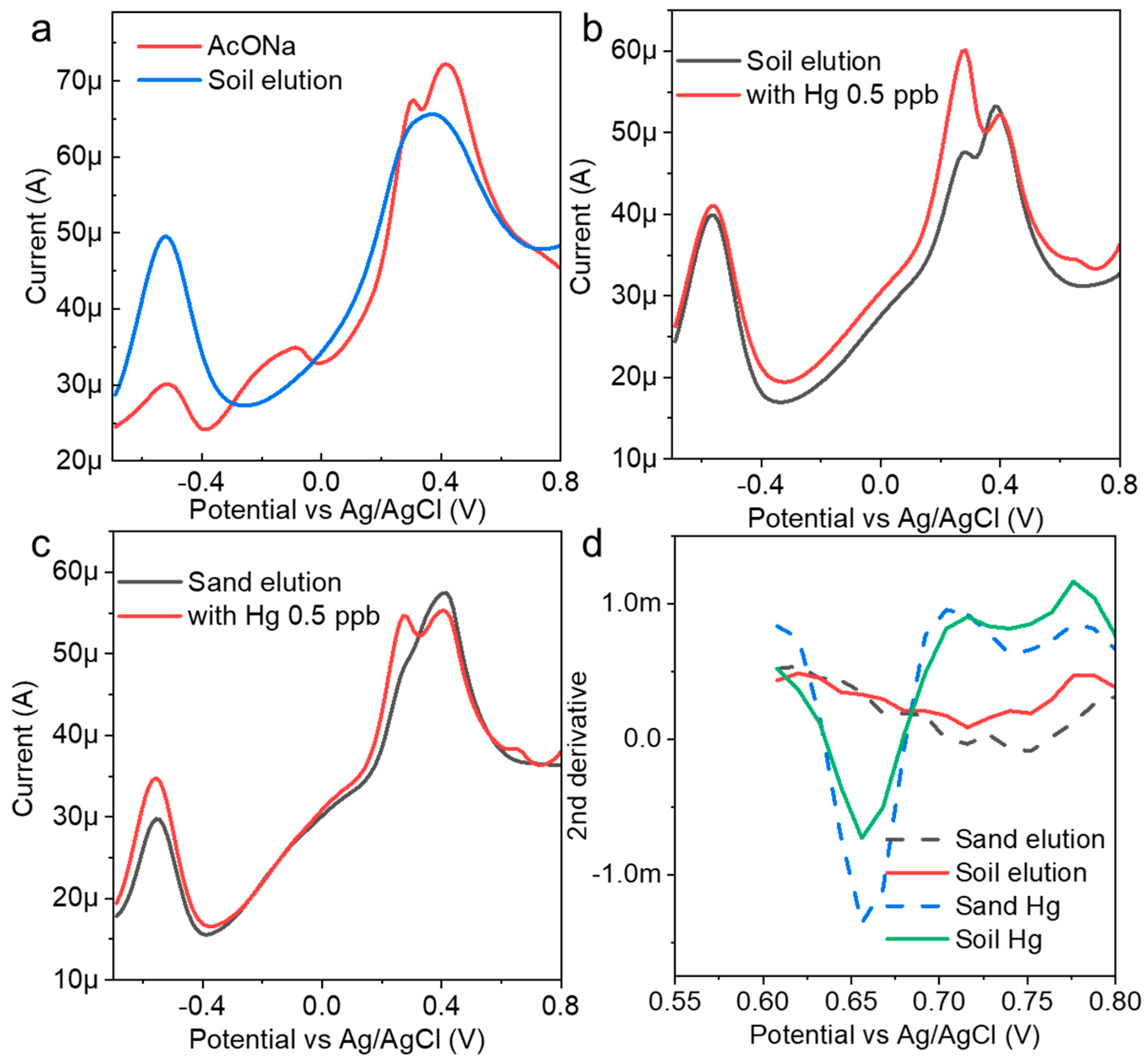
Disclaimer/Publisher’s Note: The statements, opinions and data contained in all publications are solely those of the individual author(s) and contributor(s) and not of MDPI and/or the editor(s). MDPI and/or the editor(s) disclaim responsibility for any injury to people or property resulting from any ideas, methods, instructions or products referred to in the content. |
© 2024 by the authors. Licensee MDPI, Basel, Switzerland. This article is an open access article distributed under the terms and conditions of the Creative Commons Attribution (CC BY) license (https://creativecommons.org/licenses/by/4.0/).
Share and Cite
Takemura, K.; Iwasaki, W.; Morita, N.; Ohmagari, S.; Takaki, Y.; Fukaura, H.; Kikunaga, K. Determination of Low Concentrations of Mercury Based on the Electrodeposition Time. Nanomaterials 2024, 14, 981. https://doi.org/10.3390/nano14110981
Takemura K, Iwasaki W, Morita N, Ohmagari S, Takaki Y, Fukaura H, Kikunaga K. Determination of Low Concentrations of Mercury Based on the Electrodeposition Time. Nanomaterials. 2024; 14(11):981. https://doi.org/10.3390/nano14110981
Chicago/Turabian StyleTakemura, Kenshin, Wataru Iwasaki, Nobutomo Morita, Shinya Ohmagari, Yasunori Takaki, Hitomi Fukaura, and Kazuya Kikunaga. 2024. "Determination of Low Concentrations of Mercury Based on the Electrodeposition Time" Nanomaterials 14, no. 11: 981. https://doi.org/10.3390/nano14110981
APA StyleTakemura, K., Iwasaki, W., Morita, N., Ohmagari, S., Takaki, Y., Fukaura, H., & Kikunaga, K. (2024). Determination of Low Concentrations of Mercury Based on the Electrodeposition Time. Nanomaterials, 14(11), 981. https://doi.org/10.3390/nano14110981






